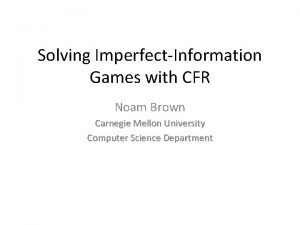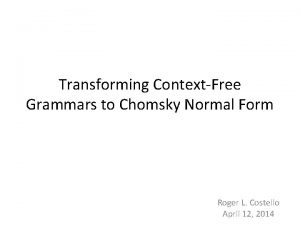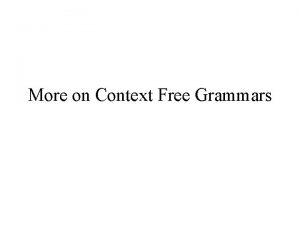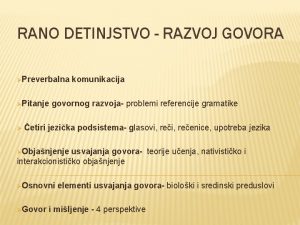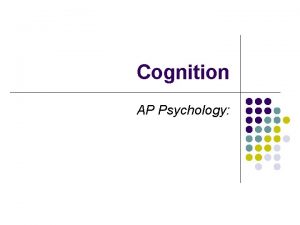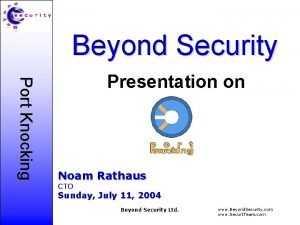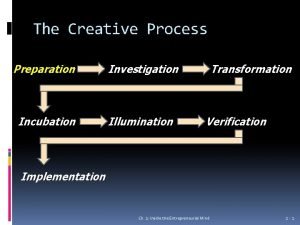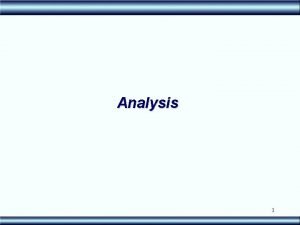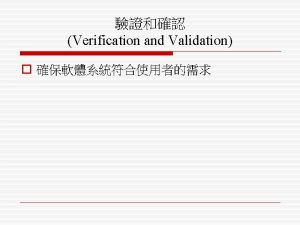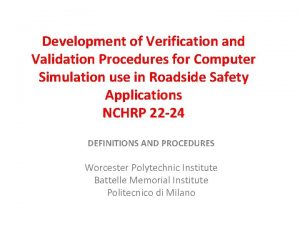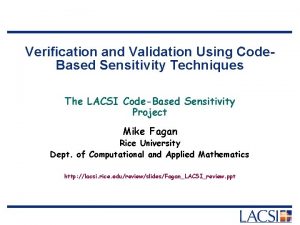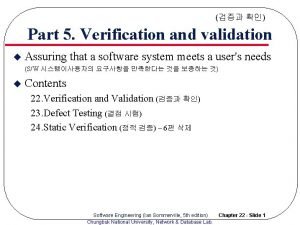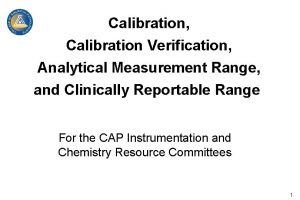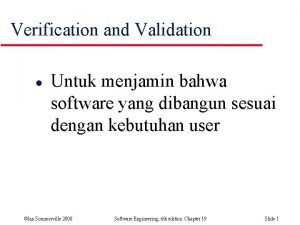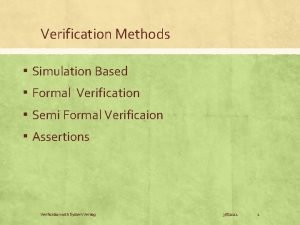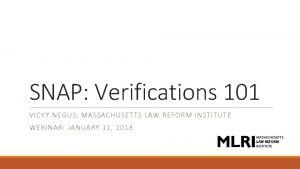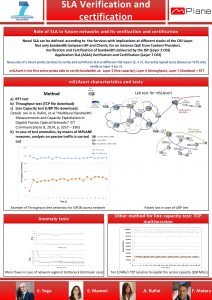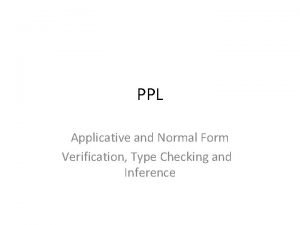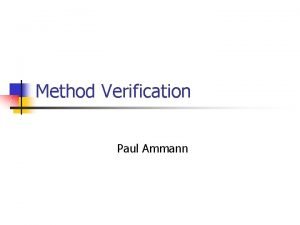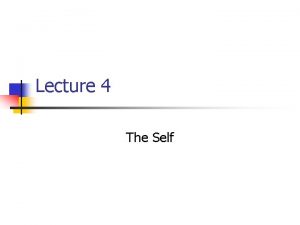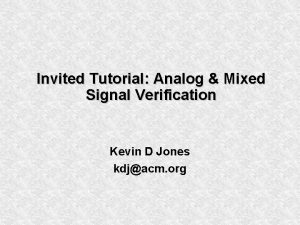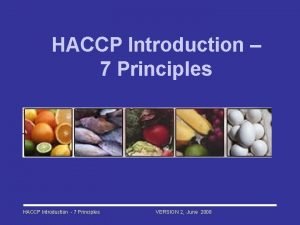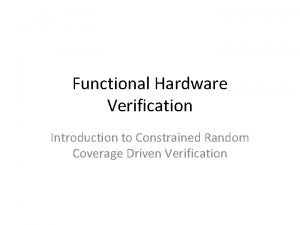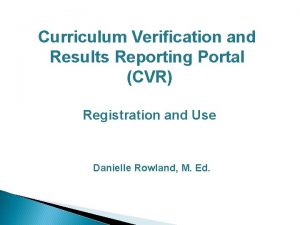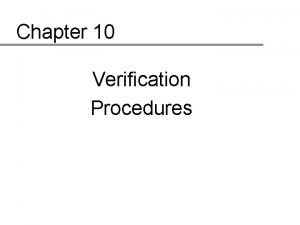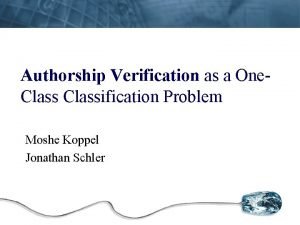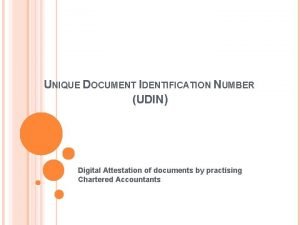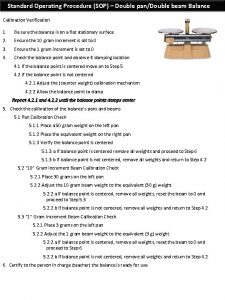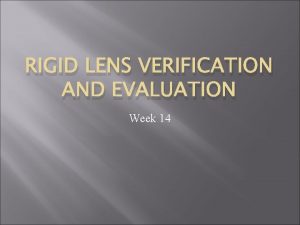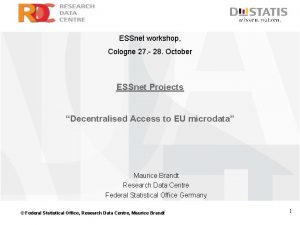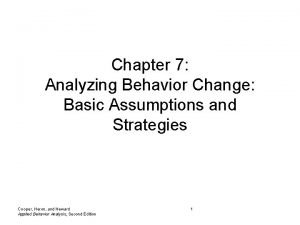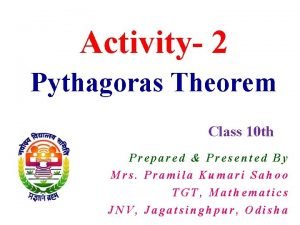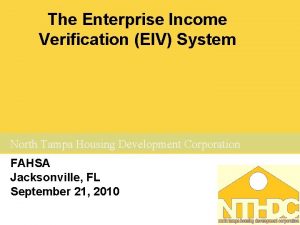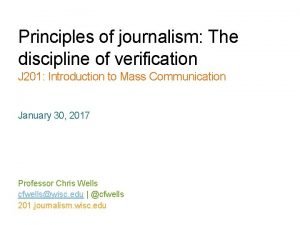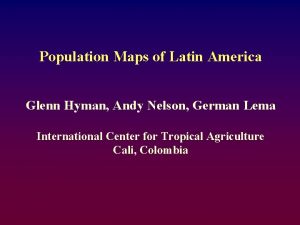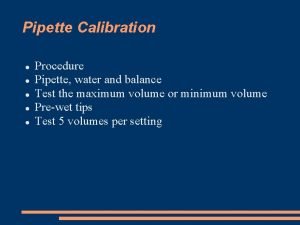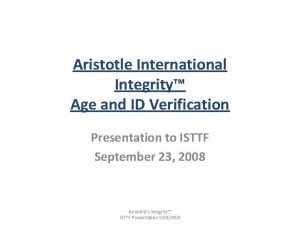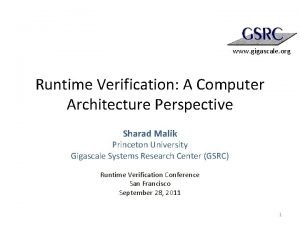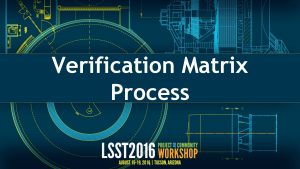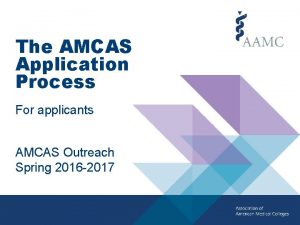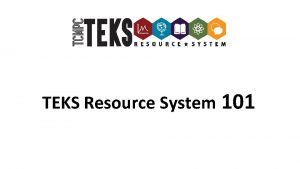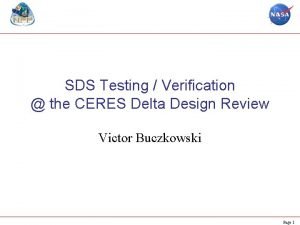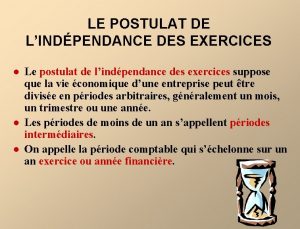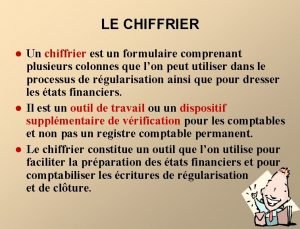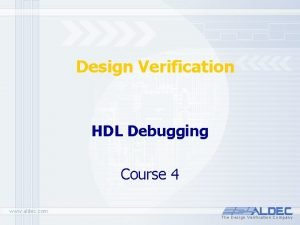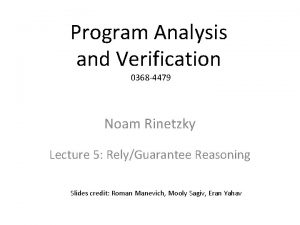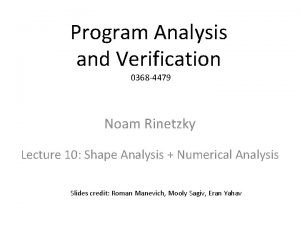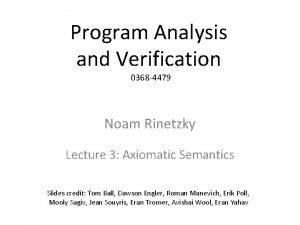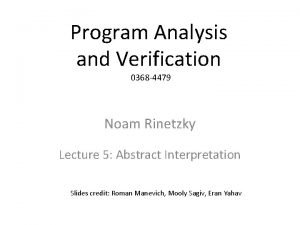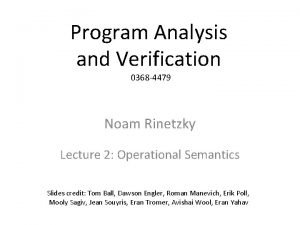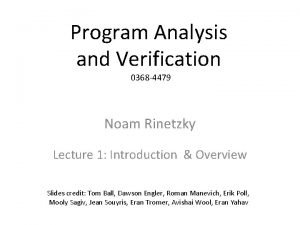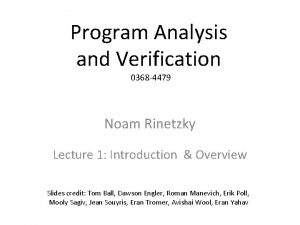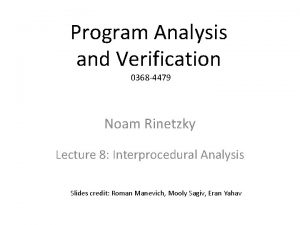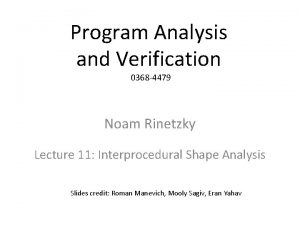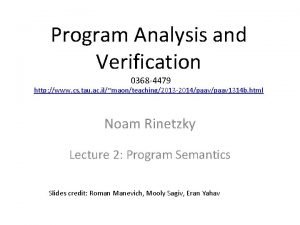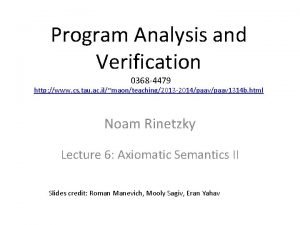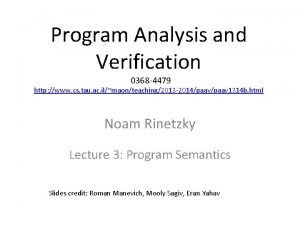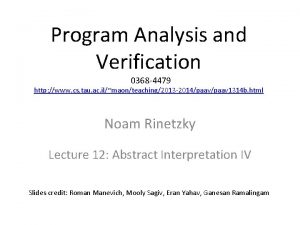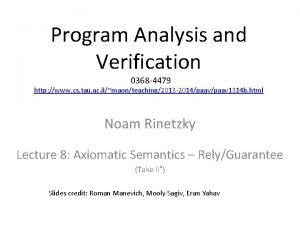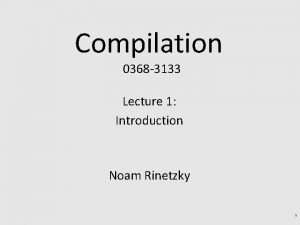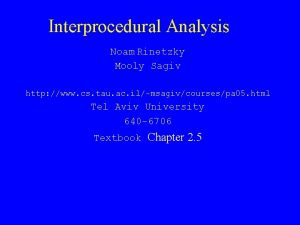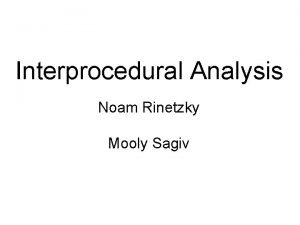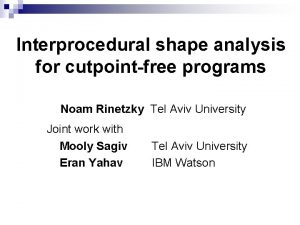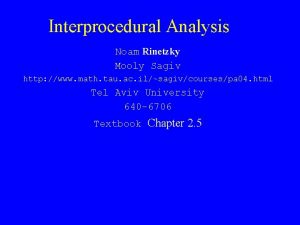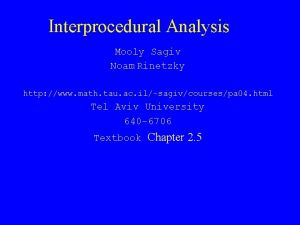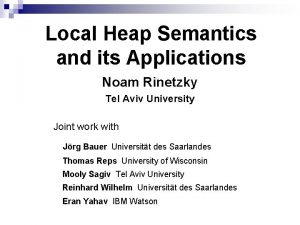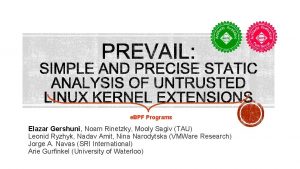Program Analysis and Verification 0368 4479 Noam Rinetzky

![Abstract Interpretation [Cousot’ 77] • Mathematical foundation of static analysis 2 Abstract Interpretation [Cousot’ 77] • Mathematical foundation of static analysis 2](https://slidetodoc.com/presentation_image_h2/fd86f693e8ce7832b06d68b7cc6d1952/image-2.jpg)
![Abstract Interpretation [Cousot’ 77] • Mathematical foundation of static analysis – Abstract (semantic) domains Abstract Interpretation [Cousot’ 77] • Mathematical foundation of static analysis – Abstract (semantic) domains](https://slidetodoc.com/presentation_image_h2/fd86f693e8ce7832b06d68b7cc6d1952/image-3.jpg)
![Abstract Interpretation [CC 77] • A very general mathematical framework for approximating semantics – Abstract Interpretation [CC 77] • A very general mathematical framework for approximating semantics –](https://slidetodoc.com/presentation_image_h2/fd86f693e8ce7832b06d68b7cc6d1952/image-4.jpg)


























![handling conditions: Goal [ifp] { b �P } S 1 { Q }, { handling conditions: Goal [ifp] { b �P } S 1 { Q }, {](https://slidetodoc.com/presentation_image_h2/fd86f693e8ce7832b06d68b7cc6d1952/image-31.jpg)
![handling conditions: Goal [ifp] { b �P } S 1 { Q }, { handling conditions: Goal [ifp] { b �P } S 1 { Q }, {](https://slidetodoc.com/presentation_image_h2/fd86f693e8ce7832b06d68b7cc6d1952/image-32.jpg)
![Annotating conditions [ifp] { b �P } S 1 { Q }, { � Annotating conditions [ifp] { b �P } S 1 { Q }, { �](https://slidetodoc.com/presentation_image_h2/fd86f693e8ce7832b06d68b7cc6d1952/image-33.jpg)
![Joining predicates [ifp] { b �P } S 1 { Q }, { � Joining predicates [ifp] { b �P } S 1 { Q }, { �](https://slidetodoc.com/presentation_image_h2/fd86f693e8ce7832b06d68b7cc6d1952/image-34.jpg)


![Handling conditional expressions • F[assume bexpr] : such that Conj(D) �bexpr �Conj(F[assume bexpr]) • Handling conditional expressions • F[assume bexpr] : such that Conj(D) �bexpr �Conj(F[assume bexpr]) •](https://slidetodoc.com/presentation_image_h2/fd86f693e8ce7832b06d68b7cc6d1952/image-37.jpg)








![CP abstract transformer • Goal: define a function FCP[x: =aexpr] : such that if CP abstract transformer • Goal: define a function FCP[x: =aexpr] : such that if](https://slidetodoc.com/presentation_image_h2/fd86f693e8ce7832b06d68b7cc6d1952/image-46.jpg)
![CP abstract transformer • Goal: define a function FCP[x: =aexpr] : such that if CP abstract transformer • Goal: define a function FCP[x: =aexpr] : such that if](https://slidetodoc.com/presentation_image_h2/fd86f693e8ce7832b06d68b7cc6d1952/image-47.jpg)



![Does this still work? let Pt = F[assume bexpr] P let Pf = F[assume Does this still work? let Pt = F[assume bexpr] P let Pf = F[assume](https://slidetodoc.com/presentation_image_h2/fd86f693e8ce7832b06d68b7cc6d1952/image-51.jpg)




![Abstract Interpretation [Cousot’ 77] More Formally … • Mathematical foundation of static analysis 56 Abstract Interpretation [Cousot’ 77] More Formally … • Mathematical foundation of static analysis 56](https://slidetodoc.com/presentation_image_h2/fd86f693e8ce7832b06d68b7cc6d1952/image-56.jpg)
![Abstract Interpretation [Cousot’ 77] • Mathematical framework for approximating semantics (aka abstraction) – Allows Abstract Interpretation [Cousot’ 77] • Mathematical framework for approximating semantics (aka abstraction) – Allows](https://slidetodoc.com/presentation_image_h2/fd86f693e8ce7832b06d68b7cc6d1952/image-57.jpg)
![Abstract Interpretation [Cousot’ 77] • Mathematical foundation of static analysis – Abstract domains • Abstract Interpretation [Cousot’ 77] • Mathematical foundation of static analysis – Abstract domains •](https://slidetodoc.com/presentation_image_h2/fd86f693e8ce7832b06d68b7cc6d1952/image-58.jpg)















































- Slides: 105

Program Analysis and Verification 0368 -4479 Noam Rinetzky Lecture 6: Abstract Interpretation Slides credit: Roman Manevich, Mooly Sagiv, Eran Yahav
![Abstract Interpretation Cousot 77 Mathematical foundation of static analysis 2 Abstract Interpretation [Cousot’ 77] • Mathematical foundation of static analysis 2](https://slidetodoc.com/presentation_image_h2/fd86f693e8ce7832b06d68b7cc6d1952/image-2.jpg)
Abstract Interpretation [Cousot’ 77] • Mathematical foundation of static analysis 2
![Abstract Interpretation Cousot 77 Mathematical foundation of static analysis Abstract semantic domains Abstract Interpretation [Cousot’ 77] • Mathematical foundation of static analysis – Abstract (semantic) domains](https://slidetodoc.com/presentation_image_h2/fd86f693e8ce7832b06d68b7cc6d1952/image-3.jpg)
Abstract Interpretation [Cousot’ 77] • Mathematical foundation of static analysis – Abstract (semantic) domains (“abstract states”) – Transformer functions (“abstract steps”) – Chaotic iteration (“abstract computation”) 3
![Abstract Interpretation CC 77 A very general mathematical framework for approximating semantics Abstract Interpretation [CC 77] • A very general mathematical framework for approximating semantics –](https://slidetodoc.com/presentation_image_h2/fd86f693e8ce7832b06d68b7cc6d1952/image-4.jpg)
Abstract Interpretation [CC 77] • A very general mathematical framework for approximating semantics – Generalizes Hoare Logic – Generalizes weakest precondition calculus • Allows designing sound static analysis algorithms – Usually compute by iterating to a fixed-point – Not specific to any programming language style • Results of an abstract interpretation are (loop) invariants – Can be interpreted as axiomatic verification assertions and used for verification 4

Abstract Interpretation in 5 Slides • Disclaimer – Do not worry if you feel that you do not understand the next 5 slides • You are not expected to … – This is just to give you a view of the land …

Collecting semantics • For a set of program states State, we define the collecting lattice (2 State, � , � , State) • The collecting semantics accumulates the (possibly infinite) sets of states generated during the execution – Not computable in general 6

“Proof” x Z entry x Z if x>0 {x<=0} {x>0} x: = x + 1 {x>1} x : = x-1 {x<0} x : = x-1 {x<-1} 7

Abstract (conservative) interpretation abstract representation statement S abstract semantics concretization set of states abstract representation concretization statement S operational semantics (concrete semantics) set of states � set of states 8

Abstract (conservative) interpretation x = x -1 0<x abstract semantics concretization {x↦ 1, x↦ 2, …} 0≤x concretization x=x-1 operational semantics (concrete semantics) {x↦ 0, x↦ 1, …} �{x↦ 0, x↦ 1, …} 9

Abstract (conservative) interpretation x = x -1 0<x abstract semantics concretization {x↦ 1, x↦ 2, …} � concretization x=x-1 operational semantics (concrete semantics) {x↦ 0, x↦ 1, …} � {…, x↦ 0, …} 10

Abstract (non-conservative) interpretation x = x -1 0<x concretization {x↦ 1, x↦ 2, …} 0<x abstract semantics concretization x=x-1 operational semantics (concrete semantics) {x↦ 0, x↦ 1, …} ⊈ { x↦ 1, …} 11

Abstract Interpretation by Example

Available Expressions Analysis • A static analysis that infers for every program point a set of facts of the form AV = { x = y | x, y �Var } � { x = - y | x, y �Var } � { x = y op z | y, z �Var, op �{+, -, *, <=} } • For every program with n=|Var| variables number of possible facts is finite: |AV|=O(n 3) – Yields a trivial algorithm … but, is it efficient? 13

What do we need to prove? { true } C 1 x : = a op b C 2 { x = a op b } y : = a op b C 3 CSE { true } C 1 x : = a op b C 2 { x = a op b } y : = x C 3 14

Developing a theory of approximation • Formulae are suitable for many analysis-based proofs but we may want to represent predicates in other ways: – Sets of “facts” – Automata – Linear (in)equalities – … ad-hoc representation • Wanted: a uniform theory to represent semantic values and approximations 15

Preorder • We say that a binary order relation �over a set D is a preorder if the following conditions hold for every d, d’’ �D – Reflexive: d �d – Transitive: d �d’ and d’ �d’’ implies d �d’’ • There may exist d, d’ such that d �d’ and d’ �d yet d �d’ 16

Partial order • A binary order relation �over a set D is a partial order if – �is a preorder – �is anti-symmetric • For any d, d’ if d �d’ and d’ �d then d = d’ • Notation: if d �d’ and d �d’ we write d �d’ 17

Some posets-related terminology • If x �y we can say – x is lower than y – x is more precise than y – x is more concrete than y – x under-approximates y – y is greater than x – y is less precise than x – y is more abstract than x – y over-approximates x 18

Intuition • {x > 0} �x Z

Pointed poset • A poset (D, � ) with a least element �is called a pointed poset, and denoted by (D , � ) • For all d� D we have that ��d • We can always transform a poset (D, � ) into a pointed poset by adding a special bottom element (D �{� }, ��{� � d | d� D}, � ) 20

Join operator • Assume a poset (D, � ) • Let X �D be a subset of D (finite/infinite) • The join of X is defined as –� X = the least upper bound (LUB) of all elements in X if it exists –� X = min�{ b | forall x� X we have that x� b} – The supremum of the elements in X – A kind of abstract union (disjunction) operator • Properties of a join operator – Commutative: x �y = y �x – Associative: (x �y) �z = x �(y �z) – Idempotent: x �x = x 21

Join operator • Assume a poset (D, � ) • Let X �D be a subset of D (finite/infinite) • The join of X is defined as –� X = the least upper bound (LUB) of all elements in X if it exists –� X = min�{ b | forall x� X we have that x� b} – The supremum of the elements in X – A kind of abstract union (disjunction) operator • Properties of a join operator – Commutative: x �y = y �x – Associative: (x �y) �z = x �(y �z) – Idempotent: x �x = x 22

Meet operator • Assume a poset (D, � ) • Let X �D be a subset of D (finite/infinite) • The meet of X is defined as –� X = the greatest lower bound (GLB) of all elements in X if it exists –� X = max�{ b | forall x� X we have that b� x} – The infimum of the elements in X – A kind of abstract intersection (conjunction) operator • Properties of a join operator – Commutative: x �y = y �x – Associative: (x �y) �z = x �(y �z) – Idempotent: x �x = x 23

Meet operator • Assume a poset (D, � ) • Let X �D be a subset of D (finite/infinite) • The meet of X is defined as –� X = the greatest lower bound (GLB) of all elements in X if it exists –� X = max�{ b | forall x� X we have that b� x} – The infimum of the elements in X – A kind of abstract intersection (conjunction) operator • Properties of a join operator – Commutative: x �y = y �x – Associative: (x �y) �z = x �(y �z) – Idempotent: x �x = x 24

Complete lattices A complete lattice (D, � , � , � ) is A set of elements D A partial order x �y A join operator � A meet operator � A bottom element �= �D • A top element �= �D = �� • • • 25

Transfer Functions • Mathematical foundations

Towards an automatic proof • Goal: automatically compute an annotated program proving as many facts of the form x = y + z as possible • Decision 1: develop a forward-going proof • Decision 2: draw predicates from a finite set D – “looking under the light of the lamp” – A compromise that simplifies problem by focusing attention – possibly miss some facts that hold • Challenge 1: handle straight-line code • Challenge 2: handle conditions • Challenge 3: handle loops 27

Domain for SAV • Define atomic facts (for SAV) as = { x = y | x, y �Var } �{ x = y + z | x, y, z �Var } – For n=|Var| number of atomic facts is O(n 3) • Define sav-predicates as = 2 • For D � , Conj(D) = � D – Conj({a=b, c=b+d, b=c}) = (a=b) �(c=b+d) �(b=c) • Note: – Conj(D 1 �D 2) = Conj(D 1) �Conj(D 1) – Conj({}) �true 28

Visualizing ordering for SAV Greater {true} {x=y}* {y=z+a}* {p=q}* {x=y �y=z+a}* {x=y �p=q}* {y=z+a �p=q}* {false} D={x=y, y=x, p=q, q=p, y=z+a, y=a+z, z=y+z, x=z+a} Lower 29

An algorithm for annotating SLP • Annotate(P, x: =a) = {P} x: =a F*[x: =a](P) • Annotate(P, S 1; S 2) = {P} S 1; {Q 1} S 2 {Q 2 – Annotate(P, S 1) = {P} S 1 {Q 1} – Annotate(Q 1, S 2) = {Q 1} S 2 {Q 2} 30
![handling conditions Goal ifp b P S 1 Q handling conditions: Goal [ifp] { b �P } S 1 { Q }, {](https://slidetodoc.com/presentation_image_h2/fd86f693e8ce7832b06d68b7cc6d1952/image-31.jpg)
handling conditions: Goal [ifp] { b �P } S 1 { Q }, { � b �P } S 2 { Q } { P } if b then S 1 else S 2 { Q } • Annotate a program if b then S 1 else S 2 with predicates from • Assumption 1: P is given (otherwise use true) • Assumption 2: b is a simple binary expression e. g. , x=y, x<y (why? ) {P} if b then { b �P } S 1 { Q 1 } else {� b �P } S 2 { Q 2 } {Q} 31
![handling conditions Goal ifp b P S 1 Q handling conditions: Goal [ifp] { b �P } S 1 { Q }, {](https://slidetodoc.com/presentation_image_h2/fd86f693e8ce7832b06d68b7cc6d1952/image-32.jpg)
handling conditions: Goal [ifp] { b �P } S 1 { Q }, { � b �P } S 2 { Q } { P } if b then S 1 else S 2 { Q } • Annotate a program if b then S 1 else S 2 with predicates from • Assumption 1: P is given (otherwise use true) • Assumption 2: b is a simple binary expression e. g. , x=y, x<y (why? ) {P} if b then { b �P } S 1 { Q 1 } else {� b �P } S 2 { Q 2 } {Q} 32
![Annotating conditions ifp b P S 1 Q Annotating conditions [ifp] { b �P } S 1 { Q }, { �](https://slidetodoc.com/presentation_image_h2/fd86f693e8ce7832b06d68b7cc6d1952/image-33.jpg)
Annotating conditions [ifp] { b �P } S 1 { Q }, { � b �P } S 2 { Q } { P } if b then S 1 else S 2 { Q } 1. Start with P or {b �P} and annotate S 1 (yielding Q 1) 2. Start with P or {� b �P} and annotate S 2 (yielding Q 2) 3. How do we infer a Q such that Q 1� Q and Q 2� Q? Q 1=Conj(D 1), Q 2 Possibly =Conj(D 2) an SAV-fact Define: Q = Q 1 �Q 2 = Conj(D 1 �D 2) Possibly an SAV-fact {P} if b then { b �P } S 1 { Q 1 } else {� b �P } S 2 { Q 2 } {Q} 33
![Joining predicates ifp b P S 1 Q Joining predicates [ifp] { b �P } S 1 { Q }, { �](https://slidetodoc.com/presentation_image_h2/fd86f693e8ce7832b06d68b7cc6d1952/image-34.jpg)
Joining predicates [ifp] { b �P } S 1 { Q }, { � b �P } S 2 { Q } { P } if b then S 1 else S 2 { Q } 1. Start with P or {b �P} and annotate S 1 (yielding Q 1) 2. Start with P or {� b �P} and annotate S 2 (yielding Q 2) 3. How do we infer a Q such that Q 1� Q and Q 2� Q? Q 1=Conj(D 1), Q 2=Conj(D 2) Define: Q = Q 1 �Q 2 = Conj(D 1 �D 2) The join operator for SAV {P} if b then { b �P } S 1 { Q 1 } else {� b �P } S 2 { Q 2 } {Q} 34

Joining predicates • Q 1=Conj(D 1), Q 2=Conj(D 2) • We want to soundly approximate Q 1 �Q 2 in • Define: Q = Q 1 �Q 2 = Conj(D 1 �D 2) • Notice that Q 1� Q and Q 2� Q meaning Q 1 �Q 2 � Q 35

Handling conditional expressions • Let D be a set of facts and b be an expression • Goal: Elements in that soundly approximate – D �bexpr – D �� bexpr • Technique: Add statement assume bexpr sos s if B bexpr s = tt � assume bexpr, s�� • Find a function F[assume bexpr] : Conj(D) �bexpr �Conj(F[assume bexpr]) 36
![Handling conditional expressions Fassume bexpr such that ConjD bexpr ConjFassume bexpr Handling conditional expressions • F[assume bexpr] : such that Conj(D) �bexpr �Conj(F[assume bexpr]) •](https://slidetodoc.com/presentation_image_h2/fd86f693e8ce7832b06d68b7cc6d1952/image-37.jpg)
Handling conditional expressions • F[assume bexpr] : such that Conj(D) �bexpr �Conj(F[assume bexpr]) • � (bexpr) = if bexpr is an SAV-fact then {bexpr} else {} – Notice bexpr �� (bexpr) – Examples • � (y=z) = {y=z} • � (y<z) = {} • F[assume bexpr](D) = D �� (bexpr) 37

Example { } if (x = y) { x=y, y=x } a : = b + c { x=y, y=x, a=b+c, a=c+b } d : = b – c { x=y, y=x, a=b+c, a=c+b } else { } a : = b + c { a=b+c, a=c+b } d : = b + c { a=b+c, a=c+b, d=b+c, d=c+b, a=d, d=a } { a=b+c, a=c+b } 38

Example { } if (x = y) { x=y, y=x } a : = b + c { x=y, y=x, a=b+c, a=c+b } d : = b – c { x=y, y=x, a=b+c, a=c+b } else { } a : = b + c { a=b+c, a=c+b } d : = b + c { a=b+c, a=c+b, d=b+c, d=c+b, a=d, d=a } { a=b+c, a=c+b } 39

Handling assumes • Meet or join?

Another Example

Constant Propagation (CP) • Goal: infers facts of the form x=c 42

Motivation: Constant folding • Optimization: constant folding { x=c } y : = aexpr constant folding simplifies constant expressions y : = eval(aexpr[c/x]) – Example: x: =7; y: =x*9 transformed to: x: =7; y: =7*9 and then to: x: =7; y: =63 43

CP semantic domain ? 44

CP semantic domain • Define CP-factoids: = { x = c | x �Var, c �Z } – How many factoids are there? • Define predicates as = 2 – How many predicates are there? – Do all predicates make sense? (x=5) �(x=7) • Treat conjunctive formulas as sets of factoids {x=5, y=7} ~ (x=5) �(y=7) 45
![CP abstract transformer Goal define a function FCPx aexpr such that if CP abstract transformer • Goal: define a function FCP[x: =aexpr] : such that if](https://slidetodoc.com/presentation_image_h2/fd86f693e8ce7832b06d68b7cc6d1952/image-46.jpg)
CP abstract transformer • Goal: define a function FCP[x: =aexpr] : such that if FCP[x: =aexpr] P = P’ then sp(x: =aexpr, P) �P’ ? 46
![CP abstract transformer Goal define a function FCPx aexpr such that if CP abstract transformer • Goal: define a function FCP[x: =aexpr] : such that if](https://slidetodoc.com/presentation_image_h2/fd86f693e8ce7832b06d68b7cc6d1952/image-47.jpg)
CP abstract transformer • Goal: define a function FCP[x: =aexpr] : such that if FCP[x: =aexpr] P = P’ then sp(x: =aexpr, P) �P’ [kill] { x=c } x: =aexpr { } [gen-1] { } x: =c { x=c } [gen-2] [preserve] { y=c, z=c’ } x: =y op z { x=c op c’ } { y=c } x: =aexpr { y=c } 47

Gen-kill formulation of transformers • Suited for analysis propagating sets of factoids – Available expressions, – Constant propagation, etc. • For each statement, define a set of killed factoids and a set of generated factoids F[S] P = (P kill(S)) �gen(S) • FCP[x: =aexpr] P = (P {x=c}) aexpr is not a constant • FCP[x: =k] P = (P {x=c}) �{x=k} • Used in dataflow analysis – a special case of abstract interpretation 48

Does this still work? Annotate(P, S 1; S 2) = let Annotate(P, S 1) be {P} A 1 {Q 1} let Annotate(Q 1, S 2) be {Q 1} A 2 {Q 2} return {P} A 1; {Q 1} A 2 {Q 2} 49

Handling conditional expressions • We want to soundly approximate D �bexpr and D �� bexpr in • Define an artificial statement assume bexpr sos s if B bexpr s = tt � assume bexpr, s�� • Define � (bexpr) = if bexpr is CP-factoid {bexpr} else {} • Define F[assume bexpr](D) = D �� (bexpr) 50
![Does this still work let Pt Fassume bexpr P let Pf Fassume Does this still work? let Pt = F[assume bexpr] P let Pf = F[assume](https://slidetodoc.com/presentation_image_h2/fd86f693e8ce7832b06d68b7cc6d1952/image-51.jpg)
Does this still work? let Pt = F[assume bexpr] P let Pf = F[assume � bexpr] P let Annotate(Pt, S 1) be {Pt} S 1 {Q 1} let Annotate(Pf, S 2) be {Pf} S 2 {Q 2} return {P} if bexpr then {Pt} S 1 {Q 1} else {Pf} S 2 {Q 2} {Q 1 �Q 2} How do we define join for CP? 51

Join example • {x=5, y=7} �{x=3, y=7, z=9} = 52

Does this still work? Annotate(P, while bexpr do S) = N’ : = Nc : = P // Initialize repeat let Pt = F[assume bexpr] Nc let Annotate(Pt, S) be {Nc} Abody {N’} Nc : = Nc �N’ until N’ = Nc return {P} INV= {N’} while bexpr do {Pt} Abody {F[assume � bexpr](N)} • What about correctness? • What about termination? 53

Does this still work? Annotate(P, while bexpr do S) = N’ : = Nc : = P // Initialize repeat let Pt = F[assume bexpr] Nc let Annotate(Pt, S) be {Nc} Abody {N’} Nc : = Nc �N’ until N’ = Nc return {P} INV= {N’} while bexpr do {Pt} Abody {F[assume � bexpr](N)} • What about correctness? – If loop terminates then is N’ a loop invariant? • What about termination? 54

What were the common elements? • Two static analyses – Available Expressions (extended with equalities) – Constant Propagation • Semantic domain – An approximation relation � • A weaker one given by set inclusion – Join operator • Abstract transformers for basic statements – Assignments – assume statements • Initial precondition 55
![Abstract Interpretation Cousot 77 More Formally Mathematical foundation of static analysis 56 Abstract Interpretation [Cousot’ 77] More Formally … • Mathematical foundation of static analysis 56](https://slidetodoc.com/presentation_image_h2/fd86f693e8ce7832b06d68b7cc6d1952/image-56.jpg)
Abstract Interpretation [Cousot’ 77] More Formally … • Mathematical foundation of static analysis 56
![Abstract Interpretation Cousot 77 Mathematical framework for approximating semantics aka abstraction Allows Abstract Interpretation [Cousot’ 77] • Mathematical framework for approximating semantics (aka abstraction) – Allows](https://slidetodoc.com/presentation_image_h2/fd86f693e8ce7832b06d68b7cc6d1952/image-57.jpg)
Abstract Interpretation [Cousot’ 77] • Mathematical framework for approximating semantics (aka abstraction) – Allows designing sound static analysis algorithms • Usually compute by iterating to a fixed-point – Computes (loop) invariants • Can be interpreted as axiomatic verification assertions • Generalizes Hoare Logic & WP / SP calculus 57
![Abstract Interpretation Cousot 77 Mathematical foundation of static analysis Abstract domains Abstract Interpretation [Cousot’ 77] • Mathematical foundation of static analysis – Abstract domains •](https://slidetodoc.com/presentation_image_h2/fd86f693e8ce7832b06d68b7cc6d1952/image-58.jpg)
Abstract Interpretation [Cousot’ 77] • Mathematical foundation of static analysis – Abstract domains • Abstract states ~ Assertions • Join (� ) ~ Weakening – Transformer functions • Abstract steps ~ Axioms – Chaotic iteration • Structured Programs ~ Control-flow graphs • Abstract computation ~ Loop invariants 58


Introduction to Domain Theory 60

Motivation • Let “isone” be a function that must return “ 1$” when the input string has at least a 1 and “ 0$” otherwise – isone(00… 0$) = 0$ – isone(xx… 1…$) =1$ – isone(0… 0) =? • Monotonicity: in terms of information – Output is never retracted • More information about the input is reflected in more information about the output – How do we express monotonicity precisely? 61

Montonicity • Define a partial order x �y – A partial order is reflexive, transitive, and anti-symmetric – y is a refinement of x • “more precise” • For streams of bits x � y when x is a prefix of y • For programs, a typical order is: – No output (yet) �some output 62

Montonicity • A set equipped with a partial order is a poset • Definition: – D and E are postes – A function f: D E is monotonic if x, y D: x � D y f(x) � E f(y) – The semantics of the program ought to be a monotonic function • More information about the input leads to more information about the output 63

Montonicity Example • Consider our “isone” function with the prefix ordering • Notation: – 0 k is the stream with k consecutive 0’s – 0 is the infinite stream with only 0’s • Question (revisited): what is isone(0 k )? – By definition, isone(0 k$) = 0$ and isone(0 k 1$) = 1$ – But 0 k� 0 k$ and 0 k � 0 k 1$ – “isone” must be monotone, so: • isone( 0 k ) �isone( 0 k$) = 0$ • isone( 0 k ) �isone( 0 k 1$) = 1$ – Therefore, monotonicity requires that isone(0 k ) is a common prefix of 0$ and 1$, namely 64

Motivation • Are there other constraints on “isone”? • Define “isone” to satisfy the equations – – isone( )= isone(1 s)=1$ isone(0 s)=isone(s) isone($)=0$ • What about 0 ? • Continuity: finite output depends only on finite input (no infinite lookahead) – Intuition: A program that can produce observable results can do it in a finite time 65

Chains • A chain is a countable increasing sequence <xi> = {xi X | x 0 � x 1 �… } • An upper bound of a set if an element “bigger” than all elements in the set • The least upper bound is the “smallest” among upper bounds: – xi �� <xi> for all i N – � <xi> � y for all upper bounds y of <xi> and it is unique if it exists 66

Complete Partial Orders • Not every poset has an upper bound – with ��n and n� n for all n N – {1, 2} does not have an upper bound 0 1 2 … � • Sometimes chains have no upper bound � 2 The chain 1 0 1 2 … 0 does not have an upper bound 67

Complete Partial Orders • It is convenient to work with posets where every chain (not necessarily every set) has a least upper bound • A partial order P is complete if every chain in P has a least upper bound also in P • We say that P is a complete partial order (cpo) • A cpo with a least (“bottom”) element �is a pointed cpo (pcpo) 68

Examples of cpo’s • Any set P with the order x� y if and only if x = y is a cpo It is discrete or flat • If we add �so that �� x for all x P, we get a flat pointed cpo • The set N with is a poset with a bottom, but not a complete one • The set N { } with n is a pointed cpo • The set N with is a cpo without bottom • Let S be a set and P(S) denotes the set of all subsets of S ordered by set inclusion – P(S) is a pointed cpo 69

Constructing cpos • If D and E are pointed cpos, then so is D×E (x, y) �D×E (x’, y’) iff x � D x’ and y� E y’ � D×E = (� D, � E) �(x i , y i ) = ( � D xi , � E y i) 70

Constructing cpos (2) • If S is a set of E is a pcpos, then so is S E m �m’ iff s S: m(s) � E m’(s) � S E = s. � E �(m , m’ ) = s. m(s) � E m’(s) 71

Continuity • A monotonic function maps a chain of inputs into a chain of outputs: x 0 �x 1 � … f(x 0) �f(x 1) �… • It is always true that: � f(� i <f(xi)> � i <xi>) • But f(� � i <xi>)� i <f(xi)> is not always true 72

A Discontinuity Example � 3 2 1 f(� � i <xi>) � i <f(xi)> 1 0 73

Continuity • Each f(xi) uses a “finite” view of the input • f(� <xi> ) uses an “infinite” view of the input • A function is continuous when f(� <xi>) = � i <f(xi)> • The output generated using an infinite view of the input does not contain more information than all of the outputs based on finite inputs 74

Continuity • Each f(xi) uses a “finite” view of the input • f(� <xi> ) uses an “infinite” view of the input • A function is continuous when f(� <xi>) = � i <f(xi)> • The output generated using an infinite view of the input does not contain more information than all of the outputs based on finite inputs • Scott’s thesis: The semantics of programs can be described by a continuous functions 75

Examples of Continuous Functions • For the partial order ( N { }, ) – The identity function is continuous id(� ni) = � id(ni ) – The constant function “five(n)=5” is continuous five(� ni) = � five(ni ) – If isone(0 ) = then isone is continuos • For a flat cpo A, any monotonic function f: A� A� such that f is strict is continuous • Chapter 8 of the Wynskel textbook includes many more continuous functions 76

Fixed Points • Solve equation: { W(S� s� ) if B� b� ( )=true W( ) = if B� b� ( )=false � if B� b� ( )= � where W: ∑� ∑�; W= S� while b do S� 77

Fixed Points • Solve equation: { W(S� s� ) if B� b� ( )=true W( ) = if B� b� ( )=false � if B� b� ( )= � where W: ∑� ∑�; W= S� while be do s� • Alternatively, W = F(W) where: F(W) = . { W(S� s� ) if B� b� ( )=true if B� b� ( )=false � if B� b� ( )= � 78

Fixed Point (cont) • Thus we are looking for a solution for W = F( W) – a fixed point of F • Typically there are many fixed points • We may argue that W ought to be continuous W [∑� ∑�] • Cut the number of solutions • We will see how to find the least fixed point for such an equation provided that F itself is continuous 79

Fixed Point Theorem • • Define Fk = x. F( F(… F( x)…)) (F composed k times) If D is a pointed cpo and F : D D is continuous, then – – • for any fixed-point x of F and k N Fk (� ) �x The least of all fixed points is k ) � k F (� Proof: i. By induction on k. • • Base: F 0 (�) = ��x Induction step: Fk+1 (�) = F( Fk (�)) �F( x) = x k ) is a fixed-point ii. It suffices to show that � k F (� • k )) = �Fk+1 ( � k ) F(� )=� k F (� k k F (� 80

Fixed-Points (notes) • If F is continuous on a pointed cpo, we know how to find the least fixed point • All other fixed points can be regarded as refinements of the least one – They contain more information, they are more precise – In general, they are also more arbitrary 81

Fixed-Points (notes) • If F is continuous on a pointed cpo, we know how to find the least fixed point • All other fixed points can be regarded as refinements of the least one – They contain more information, they are more precise – In general, they are also more arbitrary – They also make less sense for our purposes 82

Denotational Semantics • Meaning of programs

Denotational Semantics of While • ∑�is a flat pointed cpo – A state has more information on non-termination – Otherwise, the states must be equal to be comparable (informationwise) • We want strict functions ∑� ∑� – therefore, continuous functions • The partial order on ∑� ∑� f �g iff f(x) =�or f(x) = g(x) for all x ∑� – g terminates with the same state whenever f terminates – g might terminate for more inputs 84

Denotational Semantics of While • Recall that W is a fixed point of F: [[∑� ∑�]] • F is continuous { F(w) = . w(S� s� ( )) if B� b� ( )=true if B� b� ( )=false � if B� b� ( )= � • Thus, we set S� while b do c�= � Fk(� ) – Least fixed point • Terminates least often of all fixed points • Agrees on terminating states with all fixed point 85

Denotational Semantics of While • S� skip�= . • S� X : = exp�= . [X �A� exp � ] • S� s 0 ; s 1 � = . S � s 1 � (S � s 0 � ) • S� if b then s 0 else s 1� = . if B� b� then S � s 0 � else S � s 1 � • S �while b do s�= � Fk(� ) – k=0, 1, … – F = w. . if B� b� ( )=true w(S� s� ( )) else 86



Example(3) �while x 3 do x = x -1 �= � Fk(� ) k=0, 1, … where F = w. . if (x) 3 w( [x � (x) -1]) else F 0(� ) � F 1(� ) if (x) 3 � ( [x � (x) -1]) else if (x) 3 then �else F 2(� ) if if Fk(� ) lfp(F) if (x) {3, 4, …k} then [x � 3] else � if (x) 3 then [x � 3] else � (x) 3 then F 1( [x � (x) -1] ) else (x) 3 then (if [x � (x) -1] x 3 then �else [x � (x) -1] ) else (x) 3 (if (x) 4 then �else [x � (x) -1] ) else (x) {3, 4} then [x � 3] else � 89

Complete Lattice • Let (D, � ) be a partial order • D is a complete lattice if every subset has both greatest lower bounds and least upper bounds 90

Knaster-Tarski Theorem • Let f: L L be a monotonic function on a complete lattice L • The least fixed point lfp(f) exists – lfp(f) = � {x L: f(x)� x} 91

Fixed Points � f(� ) f 2(� ) • A monotone function f: L L where (L, � , � , � ) is a complete lattice • Fix(f) = { l: l �L, f(l) = l} • Red(f) = {l: l �L, f(l) �l} • Ext(f) = {l: l �L, l �f(l)} Red(f) gfp(f) Fix(f) – l 1 �l 2 f(l 1 ) �f(l 2 ) • Tarski’s Theorem 1955: if f is monotone then: – lfp(f) = �Fix(f) = �Red(f) �Fix(f) – gfp(f) = �Fix(f) = �Ext(f) �Fix(f) Ext(f) lfp(f) f 2(� ) f(� ) � 92

Constant Propagation - Again

Constant Propagation • Optimization: constant folding { x=c } y : = aexpr simplifies constant expressions y : = eval(aexpr[c/x]) – Example: x: =7; y: =x*9 transformed to: x: =7; y: =7*9 and then to: x: =7; y: =63 • Analysis: constant propagation (CP) – Infers facts of the form x=c 94

CP semantic domain • Define CP-factoids: = { x = c | x �Var, c �Z } – How many factoids are there? • Define predicates as = 2 – How many predicates are there? – Do all predicates make sense? (x=5) �(x=7) • Treat conjunctive formulas as sets of factoids {x=5, y=7} ~ (x=5) �(y=7) 95

One lattice per variable true x� 0 x<0 true x� 0 x=0 false y� 0 x>0 y<0 y� 0 y=0 y>0 false How can we compose them? 96

Cartesian product of complete lattices • For two complete lattices L 1 = (D 1, � 1, � 1) L 2 = (D 2, � 2, � 2) • Define the poset Lcart = (D 1 D 2, � cart, � cart) as follows: – (x 1, x 2) � cart (y 1, y 2) iff x 1 � 1 y 1 x 2 � 2 y 2 –� � cart = ? • Lemma: L is a complete lattice • Define the Cartesian constructor Lcart = Cart(L 1, L 2) 97

Cartesian product example � =(� , � ) x� 0, y� 0 x� 0, y� 0 … x� 0, y� 0 x� 0, y<0 x� 0, y=0 x� 0, y>0 x<0, y<0 x<0, y=0 x<0, y>0 x=0, y<0 x=0, y=0 x=0, y>0 How does it represent (x<0� y<0) �(x>0� y>0)? … y� 0 x� 0, y� 0 … x>0, y<0 x>0, y� 0 x>0, y=0 x>0, y>0 � =(� , � ) (false, false) 98

Disjunctive completion • For a complete lattice L = (D, � , � , � ) • Define the powerset lattice L�= (2 D, � , � , � ) � � �= ? �= ? • Lemma: L�is a complete lattice • L�contains all subsets of D, which can be thought of as disjunctions of the corresponding predicates • Define the disjunctive completion constructor L�= Disj(L) 99

The base lattice CP � … {x=-2} {x=-1} {x=0} {x=1} {x=2} … � 100

The disjunctive completion of CP What is the height of this lattice? … … {x=-2} {x=-2� x=-1} {x=-1} true {x=0} {x=-2� x=0} … {x=1} {x=-2� x=1} {x=-1�x=1� x=-2} … … {x=2} … … … {x=1� x=2} {x=0�x=1� x=2} … false 101

Relational product of lattices • L 1 = (D 1, � 1, � 1) L 2 = (D 2, � 2, � 2) • Lrel = (2 D 1 D 2, � rel, � rel) as follows: – Lrel = ? 102

Relational product of lattices • L 1 = (D 1, � 1, � 1) L 2 = (D 2, � 2, � 2) • Lrel = (2 D 1 D 2, � rel, � rel) as follows: – Lrel = Disj(Cart(L 1, L 2)) • Lemma: L is a complete lattice • What does it buy us? 103

Cartesian product example true x� 0, y� 0 x� 0, y� 0 … x� 0, y� 0 x� 0, y<0 x� 0, y=0 x� 0, y>0 x<0, y<0 x<0, y=0 x<0, y>0 x=0, y<0 x=0, y=0 x=0, y>0 How does it represent (x<0� y<0) �(x>0� y>0)? … false y� 0 … x>0, y<0 x>0, y� 0 x>0, y=0 x>0, y>0 What is the height of this lattice? 104

Relational product example true x� 0 (x<0� y<0)� (x>0� y>0) y� 0 (x<0� y<0)� (x>0� y=0) y� 0 (x<0� y� 0)� (x<0� y� 0) … How does it represent (x<0� y<0) �(x>0� y>0)? false What is the height of this lattice? 105
 Noam brown
Noam brown Tzarget
Tzarget Noam goldberg
Noam goldberg Noam goldberg
Noam goldberg Noam tractinsky
Noam tractinsky Language development stages
Language development stages Chomsky normal form
Chomsky normal form Chomsky normal form 설명
Chomsky normal form 설명 Columbia
Columbia Noam čomski
Noam čomski Unlike b.f. skinner, noam chomsky believes that children
Unlike b.f. skinner, noam chomsky believes that children Noam rathaus
Noam rathaus Sce com esap program
Sce com esap program Illumination in entrepreneurship
Illumination in entrepreneurship Verification and validation
Verification and validation Verification and validation
Verification and validation Unit-6
Unit-6 Validation plan
Validation plan Verification principle strengths and weaknesses
Verification principle strengths and weaknesses Shelving and shelf rectification
Shelving and shelf rectification Asme v&v 10
Asme v&v 10 Verification and validation
Verification and validation Verification and validation
Verification and validation Verification and validation plan
Verification and validation plan Verification and validation
Verification and validation Limit of linearity in analytical chemistry
Limit of linearity in analytical chemistry A software verification and validation method. section 19
A software verification and validation method. section 19 Software verification and validation plan
Software verification and validation plan Sequential program and an event-driven program?
Sequential program and an event-driven program? Definition of stock verification
Definition of stock verification Semi formal verification
Semi formal verification Is unit testing verification or validation
Is unit testing verification or validation Twic card authentication & validation
Twic card authentication & validation Pending oelp review
Pending oelp review Cpa third party verification letters
Cpa third party verification letters Dta verification documents
Dta verification documents Obanion
Obanion Sla certification
Sla certification Ohio roster verification
Ohio roster verification Means of verification
Means of verification Dea number verification
Dea number verification Verification type
Verification type Dea number verification
Dea number verification Ommaverify
Ommaverify Zimbabwe nurses council
Zimbabwe nurses council Means of verification
Means of verification Method verification vs validation
Method verification vs validation Method verification vs validation
Method verification vs validation Self verification
Self verification Analog mixed signal verification
Analog mixed signal verification Internal verification feedback examples
Internal verification feedback examples Haccp introduction
Haccp introduction Gnitc student login
Gnitc student login Simulation phases of systemverilog verification
Simulation phases of systemverilog verification Evaas roster verification
Evaas roster verification Doh5178a
Doh5178a Vetanika
Vetanika Pennsylvania evv
Pennsylvania evv Death certificate geeky medics
Death certificate geeky medics Cvr rosters
Cvr rosters Self verification
Self verification Haccp verification
Haccp verification Authorship verification
Authorship verification Assertion based verification
Assertion based verification Udin login
Udin login Unique document identification number
Unique document identification number Thermal cycler temperature verification system
Thermal cycler temperature verification system Maryland ged verification
Maryland ged verification Double beam balance
Double beam balance Radiuscope
Radiuscope New mexico board of pharmacy license verification
New mexico board of pharmacy license verification Kvs fee collection
Kvs fee collection Nsi verification form
Nsi verification form Construction verification
Construction verification Steady state responding aba
Steady state responding aba Asset verification system oregon
Asset verification system oregon Verify pythagoras theorem class 10
Verify pythagoras theorem class 10 Acronis connection verification tool
Acronis connection verification tool Enterprise income verification
Enterprise income verification Tbote rules
Tbote rules Discipline of verification
Discipline of verification Verification meaning
Verification meaning What is z factor in pipette calibration
What is z factor in pipette calibration Pengertian logico-hypothetico-verifikatif
Pengertian logico-hypothetico-verifikatif Ctqp fiu
Ctqp fiu Aristotle identity verification
Aristotle identity verification Formal verification
Formal verification Requirements verification matrix
Requirements verification matrix Amcas work and activities tutorial
Amcas work and activities tutorial Teks resource system
Teks resource system Delta design
Delta design National verifier application
National verifier application Prediction verification replication aba
Prediction verification replication aba Cummins scholarship registration
Cummins scholarship registration Balance de vérification régularisée
Balance de vérification régularisée Balance de vérification après clôture
Balance de vérification après clôture Bccnp provisional license
Bccnp provisional license Verification
Verification Asset verification software
Asset verification software Noaa
Noaa Dea number verification
Dea number verification Relie check
Relie check Trn verification
Trn verification Chunyi peng
Chunyi peng Ccmc verification
Ccmc verification Ecfmg founded
Ecfmg founded
